SJ (Shi Jian) Satellite Series of China
EO
Mission complete
CAST
Quick facts
Overview
| Mission type | EO |
| Agency | CAST |
| Mission status | Mission complete |
| Launch date | 03 Mar 1971 |
| End of life date | 25 Oct 2013 |
| CEOS EO Handbook | See SJ (Shi Jian) Satellite Series of China summary |
SJ (Shi Jian) Satellite Series of China
Overview
Shi Jian (SJ, meaning “practice” or “experimental”) is a scientific as well as a technology demonstration minisatellite series of CAST (Chinese Academy of Space Technology) which started in the early 1970s. The series includes spin-stabilized spacecraft as well as three-axis stabilized spacecraft. An overview of the missions is given in Table 1. 1) 2)
Note: No spacecraft/mission descriptions could be found anywhere for all SJ-6 missions.
Spacecraft | Launch Date | S/C Mass | S/C Orbit | Payload |
SJ-1 (Shi Jian) | Mar. 3, 1971 | 221 kg | 266 km x 1826 km, I= 69.9º | Solar X-ray detector, Geiger counter |
SJ-2 | Sept. 20, 1981 | 250 kg | 232 km x 1598 km, I = 59.4º | Space dust/debris experiments and electromagnetic background probing |
SJ-3 | An Earth observation satellite and its payload was initially planned by CSSAR and later cancelled, only a prototype model was built in the late 1970s - eventually the CBERS mission (in cooperation with Brazil) resulted from this effort | |||
DQ-1A | Sept. 3, 1990 |
| 789 km x 811 km, I=99º | The balloon orbits were traced to estimate the density of the atmosphere |
SJ-4 | Feb. 8, 1994 | 397 kg | 210 km x 36125 km, I=28.6º | Particle detectors |
SJ-5 | May 10, 1999 | 298 kg | Sun-synchronous, 870 km | New bus, particle detectors, etc. |
SJ-6A | Sept. 8, 2004 |
| Sun-synchronous, 590 km, inclination = 97.7º, period= 96.6 min | Radiation monitoring satellites |
SJ-6C | Oct. 23, 2006 |
| Sun-synchronous, 600 km | Radiation monitoring satellites |
SJ-6E | Oct. 25, 2008 |
| Sun-synchronous, 602 km | Radiation monitoring satellites |
SJ-1 (Shi Jian-1)
The SJ-1 spacecraft is of DFH-1 heritage (DFH = Dong Fang Hong (Red is East) a Chinese communication satellite platform launched April 24, 1970). The SJ-1 satellite carried out particle measurements of cosmic rays and the inner radiation belt.

The spacecraft is of a spherical structure with a diameter of 1m, completely covered with solar cells. There are 14 pieces of silicon solar cell mounted on the trapezoidal planes of upper and lower hemispherical shells. The satellite is spin-stabilized.
The spacecraft contains a circular pressurized capsule with shortwave telemetric instruments and the ultra-shortwave beacon transmitter and receiver, as well as a silver-zinc chemical battery. Between the main capsule and outer enclosure there are four auxiliary capsules - referred to as; a) auxiliary capsule 1 with two sets of NiCd batteries and small telemetry equipment; b) auxiliary capsule 2 with the limiter and the phase-shifting adjuster network; c) auxiliary capsule 3 with a 5 cm responder, and d) auxiliary capsule 4 with a 10 cm beacon device. The minisatellite has a mass of 221 kg.
Launch: The SJ-1 spacecraft was launched on March 3, 1971 on a CZ-1 vehicle from the Jiuquan Launch Complex, China.
Mission Status
SJ-1, with a design life of 1 year, operated for 8 years. The S/C provided excellent experience in spacecraft operations.
Sensor Complement
The instruments were: the G-M counter and BE window integrating ionization chamber.
• The G-M counter was used for detecting cosmic rays and measuring the total flux of protons with energy of more than 16.4 MeV and the total flux of electrons with energy of more than 0.88 MeV.
• The BE window integrating ionization chamber was used for exploring solar X-rays.
SJ-2 (Shi Jian-2)
The objectives were to monitor and study the space dust and debris environment (update of the Chinese space debris model, development of design methods to protect against space debris) and to conduct electromagnetic background experiments. 3)
Spacecraft
SJ-2 spacecraft is spin-stabilized and sun-pointing with a total mass of 250 kg. The main body of the satellite is an octahedral pyramid with a side length of 1.2 m and an outer diameter of 615 cm. Four deployable solar wings are attached to the top of the minisatellite.
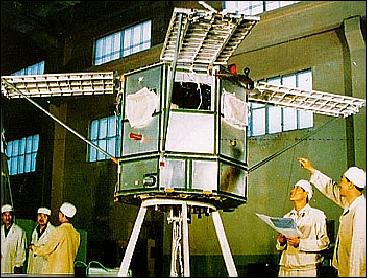
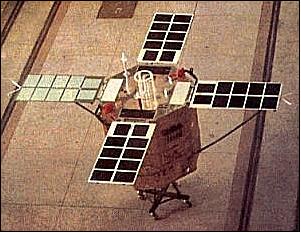
Launch
China launched the three spacecraft of the SJ-2 series (SJ-2, SJ-2A, and SJ-2B) on one launch vehicle (FB-1 or Feng Bao 1) on Sept. 20, 1981 (UTC). This represented the first multiple spacecraft launch of China and was considered as a great success with regard to space vehicle tracking, separation and control. Launch site: Jiuquan Launch Complex, China.
Orbits
• SJ-2: HEO (Highly Elliptical Orbit) of 232 km x 1598 km, inclination = 59.4º, period = 103.3 minutes.
• SJ-2A: HEO (Highly Elliptical Orbit) of 232 km x 1615 km, inclination = 59.4º, period = 103.5 minutes.
• SJ-2B: HEO (Highly Elliptical Orbit) of 232 km x 1608 km, inclination = 59.4º, period = 103.4 minutes.
Sensor Complement
The payload of about 100 kg included four instruments for space debris probing:
MMW (Millimeter Wave) Radar
The objective is to detect debris of size 3-10 cm or larger by remote sensing methods in the altitude range of 600 to 1300 km. The instrument provides measurements with a velocity resolution of <50 m/s; a direction resolution of <±1 arcsec; the time resolution is <1 s; SNR = 6.9 dB. The instrument has dimensions of 400 mm x 350 mm x 350 mm, a mass of 50 kg, and a power of 120 W.
IP (Impact Detector)
he objective is to collect particles and impacting radiation (light) signals. The instrument consists of a charge detector and a light detector, each with different collecting apertures and different viewing directions. The charge detector collects particles in the mass range of 10-7 to 10-15 g, a size range of 0.05 to 50 μm, and a velocity resolution of <10 km/s. The instrument mass is 6 kg (6 W power). - The light detector collects particles in the mass range of 10-3 to 10-7 g, a size range of 50 μm to 0.5 mm, and a velocity resolution of <10 km/s. The instrument mass is 5 kg (power 4 W).
Large Sensitive Array
The objective is to detect the total impact effect by measuring the change of the resistance. The instrument has dimensions of 1010 mm x 1010 mm x 600 mm, a mass of 7 kg and a power consumption of 6 W. It is located at the back of the solar panel.
Optical Monitor
The objective is to monitor the surface change of the two solar panels (caused by debris impacts). The instrument uses four CCD cameras which are located inside the spacecraft.
SJ-2A (Shi Jian-2A)
The SJ-2A satellite was a beacon transmitter satellite used for the detection of ionospheric electron density distributions (topside sounding applications). The frequencies of the beacon transmitter were: 162 MHz and 40.5 MHz. The principle of the measurement is that the ground station receives Doppler shift and Faraday spin of the two signs passing through the ionosphere to inverse the integrated electronic concentration of the ionosphere. The mass of the satellite is 480 kg.
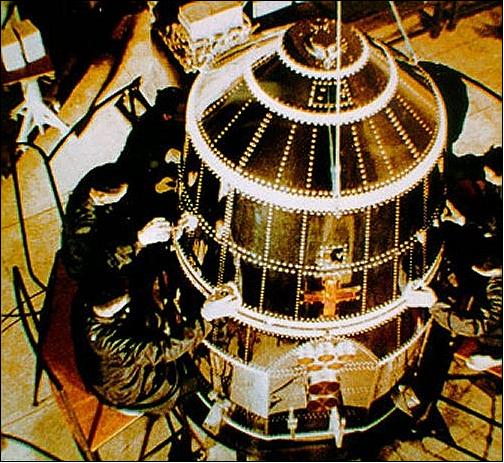
SJ-2B (Shi Jian-2B)
The SJ-2B was a passive radar calibration test satellite. A balloon with a diameter of 4 m was used as a guiding optical beacon connected with a metal ball with a diameter of 0.45 m using a 600 m silk rope, which was used for the radar's calibration.
The balloon expanded after it was placed into orbit because of sublimation and a little residual gas in it. The polyester-aluminum-plated surface of the balloon was very bright and guided the radar to find the metal ball in orbit. In the first 16 orbits, the Kashi station for 7010 radar and the Zijinshan Observatory in China acquired 5 targets in orbit and successfully carried out the radar calibration. The mass of the satellite is 257 kg.
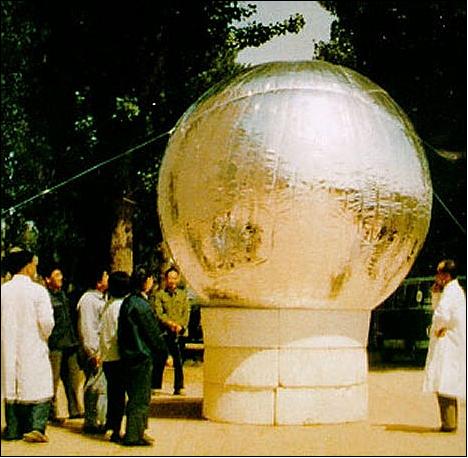
SJ-4 (Shi Jian-4)
SJ-4 is a magnetospheric mission (particles and fields research). The objective was to monitor the space radiation environment and its effects in an elliptical orbit. The S/C, built by CAST, has a mass of 397 kg with dimensions: 1.6 m diameter and 2.1 m in height.
Launch
On Feb. 8, 1994, the SJ-4 satellite was launched on an LM-3A (CZ-3A) vehicle from the Xichang Launch Complex in China.
Orbit
GTO (Geosynchronous Transfer Orbit) of 210 km x 36125 km, inclination = 28.6º.

Sensor Complement
Three instruments were designed for the space radiation environment and radiation effect test project, including a satellite surface potentiometer and two single particle effect testers (one single particle static monitor and one single particle dynamic monitor). The instruments are:
• EED (High Energy Electron Detector)
• EPS (High Energetic Proton and heavy ion Detector)
• ESA (Electrostatic Analyzer)
• SPM (Surface Potential Monitor)
• SEUM (SRAM Single Event Upset Monitor)
• SEEM (Dynamic Single Event Effect Monitor).
The plasma detector of the ESA (Electrostatic Analyzer) instrument was the first of China with the objective to detect the hot plasma which causes the high potentials on a spacecraft surface (energy range of 100 eV to 40 keV). - SJ-4 operated for about half a year and yielded a lot of science data. 4)
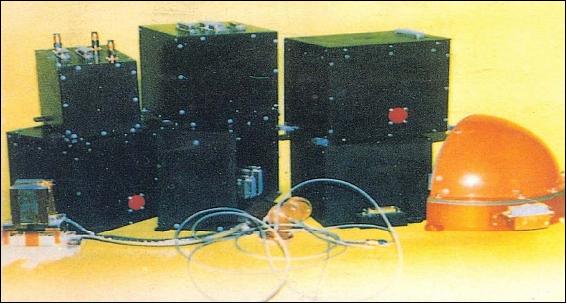
SJ-5 (Shi Jian-5)
SJ-5 is a Chinese scientific and technology demonstration satellite. It is the first modern small satellite of China with a new minisatellite platform, namely CAST968, designed and developed by CAST (Chinese Academy of Space Technology), while CSSAR (Center for Space Science & Applied Research) of CAS was responsible for the development of the payload and the ground application system. The overall objectives of the mission include: 5)
• Demonstration of advanced space technology experiments including the operation of multiple-mode attitude control, integrated onboard electronic system, a unified S-band TT&C system, S-band data transmitter, on-board data management system and large-capacity solid state storage.
• Detection of SEU (Single Event Upset) and investigation of the corresponding countermeasures. In addition, dose measurment of the high-energy particles in the space environment
• Demonstration of a space science fluid experiment.
The main goal of the SJ-5 mission was to develop a modular minisatellite platform to be used for a number of different applications.
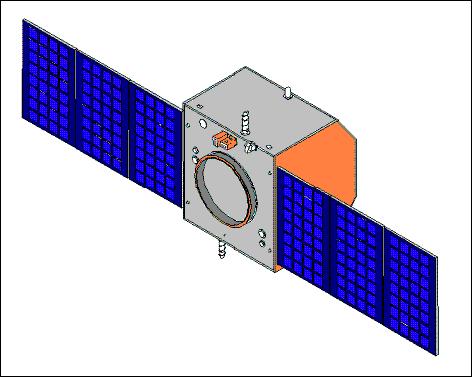
Spacecraft
SJ-5 represents the first minisatellite of China based on the modern CAST968 bus using a lightweight multifunctional aluminum honeycomb structure. The bus configuration resembles a box with overall dimensions of 1.2 m x 1.1 m x 1.04 m. The total deployed length of SJ-5 spacecraft is about 5 m.
ACS (Attitude Control Subsystem)
The ACS (Attitude Control Subsystem) features two modes of attitude stabilization, namely three-axis as well as spin-stabilized attitude control. The spin rate of the S/C is between 10-15 rpm during the spin control mode (a comparison of the two control modes is an experiment objective). Operations in spin control mode are being conducted about the axis of least inertia. The attitude measurement information is provided by a sun sensor and an infrared Earth sensor (pointing accuracy of < 0.5º, stabilization of < 0.005º/s). Actuation is provided by an offset momentum wheel, magnetorquers, and a cold-gas propulsion system (hydrazine). The 80386EX microprocessor system is used by the ACS.
The following attitude modes are provided by the ACS:
1) The nominal mode for the science payload requires sun-pointing and spin stabilization. This is accomplished by spinning the S/C at 10~15 rpm with thruster augmentation, based upon sun sensor body rates.
2) The alternate mode for the science payload requires sun-pointing and three-axis stabilization. In this mode, the attitude is controlled using a bias-momentum wheel and three magnetic torque bars.
3) The Earth-pointing mode of the spacecraft employs three-axis stabilization. In this mode, the attitude is controlled using the technique of gravity gradient with a bias-momentum wheel and three magnetic torque bars, based upon a three-axis magnetometer. An Earth sensor is used for S/C Earth pointing.
Thermal control is realized mainly by passive techniques. A redundant design is being used for key subsystems.
The following technologies were introduced/demonstrated on the newly developed SJ-5 spacecraft bus, CAST968, offering greatly improved data handling and communication capabilities, in particular with respect to future Chinese satellites.
• Use of a central computer and multiple management execution units located in each subsystem
• An onboard CAN (Controller Area Network) bus is used; interface support of MIL-STD-1553B and RS-485 is provided
• A large solid-state memory for data storage
• The CCSDS (Consultative Committee for Space Data Systems) communication protocol standard with high-speed and multi-channel technology for repeated connection (data transmission between S/C and ground)
• A high-speed data transmitter in S-band.
The total S/C mass is 298 kg; the payload mass is 58 kg; an average power of 165 W is provided by the solar array of 3.4 m2 in size (hinged panel design). NiCd batteries of 17Ah capacity are used for power supply in the orbital eclipse phase. The S/C design life is three months.
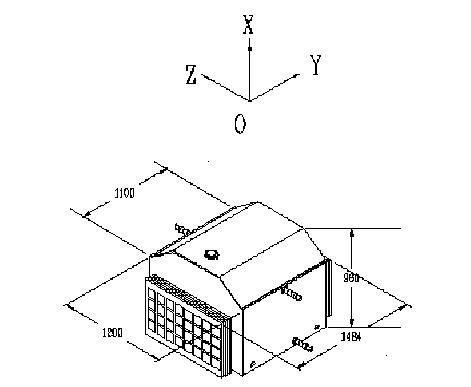
RF Communications
The spacecraft transponder was developed in China. Data transmission and tracking services are provided in S-band with 1 Mbit/s and 4 kbit/s downlink rates.
Launch
The SJ-5 satellite was launched on May 10, 1999 from the Taiyuan launch site in China as a secondary payload together with the primary payload of FY-1/C (meteorological satellite of China) on the LM-4B launch vehicle.
Orbit
Sun-synchronous near-circular orbit, mean altitude = 870 km, inclination = 98.8º, period = 102.35 minutes.
Mission Status
The science experiments were conducted during the first 3 months of the mission (until August 1999). Thereafter, various technology demonstrations and spacecraft attitude maneuvers (sun pointing, Earth pointing, etc.) were executed successfully. Spacecraft data were received until February 2000.
The development of the modern CAST968 bus, utilizing an integrated electronic concept and a new manufacturing approach, provided in particular improved capabilities and brought the operational flexibility of the spacecraft system to a higher level of performance. - The same advanced bus concept is also being used on such follow-up missions as HY-1 (launch May 15, 2002), and on the spacecraft TC-1 and TC-2 of the DSP (Double Star Project), a joint CNSA/ESA science mission with launches in 2003 and 2004. All follow-up missions are operational as of 2006.
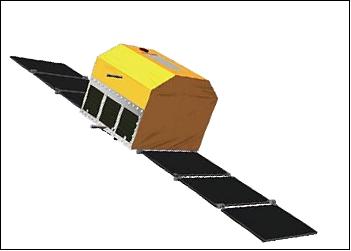
Sensor Complement
There are 11 science experiments onboard, developed by CSSAR and by the Institute of Mechanics (joint program). The experiments or instruments are:
• SEP (Single Event Phenomena) Monitor
• SEP Shielding Experiment Device
• SEU (Single Event Upset) Detector
• SEP synthetical detector
• SEL (Single Event Latch-up) Experiment
• High-energy Proton / Heavy Ion Detector
• High-energy Electron Detector
• PMOS Dosimeter (a radiation dose detector).
The eight instruments are used to measure the SEU effect and the high-energy particle environment. The observation of SEU, the investigation of the countermeasures and the measurement of the radiation in the space charged particle environment are more comprehensive compared with those in the SJ-4. With eight instruments, the investigation of SEU countermeasures includes almost all the methods known today. The measurement range of the energy spectra of the high-energy charged particles is the most completed so far, and the measurement of the radiation total dose is the first ever taken in china .The charges particles distributions in the abnormal area of the south Atlantic and in the subsiding areas of the two poles in the orbit have been obtained for the first time with the instrument developed by CSSAR. The collected data and the research results are significant for improving the design of space electronic instruments, raising the reliability and extending the satellite's service life.
Space Fluid Experiment Device
This is a micro-gravity experiment in the field of fluid mechanics. The objective is to investigate the coupling between heat capillary convection and buoyancy convection, and other phenomena under the condition of micro-gravity. The study of these phenomena and the laws governing them will advance the development of fluids. There are close relations among micro-gravity mechanics of fluids, space material science (crystal growth), space life science (cell breading) and other disciplines. Multi-layer heat capillary convection is one of frontier subjects in the micro-gravity fluid science research. The technology is very important not only for developing the methods of space crystal material growth, improving the quality of crystals, but also for a better understanding of the characteristics and the mechanisms of the convection movement of the fluid with a free surface or a boundary surface on the ground, which is a fundamental problem in the physics of fluids. This experiment in microgravity fluid mechanics is the first ever carried out by scientists in China, and also the most complex one so far. 6)
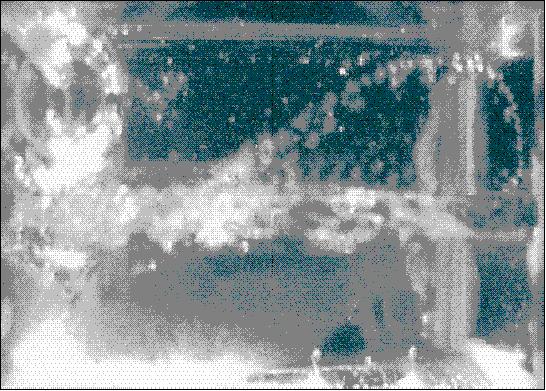
References
1) Yongwei Zhang, “China's Scientific and Technological Test Satellites,” Aerospace China, Winter 2001 Issue, URL: http://www.globalsecurity.org/space/library/news/2001/v2n4-2.htm
2) “China and Geophysics Research,” URL: http://www.globalsecurity.org/space/world/china/geophysics.htm
3) Y. L. Lin, J. Cai, H. Du, “The Third Chinese Space Science Research Mission in recent five years - Space Dust and Space Electromagnetic Background Probing Satellite,” Proceedings of the 3rd Space Debris Conference at ESA/ESOC, Darmstadt, Germany, March 19-21, 2001
4) Y. L. Lin, F. Chen, et al., “Plasma Detector on SJ-4 Satellite,” International Symposium on Space Plasma Studies by In-situ and Remote Measurements, June1-6,1998, Moscow, Russia
5) Yilin Zhu, "Small Satellites in China", Earth Space Review, Vol. 2, No. 3, 1993, pp. 20-24.
6) W. R. Hu, Y. L. Yao, Q. S. Liu, R. H. Geng, P. Zhang, L. Hu, B. H. Shou, F. Liu, “Space Experiments of Fluid Physics on Board SJ-5 Small Scientific Satellite,” IAF COSPAR Scientific Assembly, The Second World Space Congress, Houston, TX, USA, Oct. 10-19, 2002
The information compiled and edited in this article was provided by Herbert J. Kramer from his documentation of: "Observation of the Earth and Its Environment: Survey of Missions and Sensors" (Springer Verlag) as well as many other sources after the publication of the 4th edition in 2002. - Comments and corrections to this article are always welcome for further updates (eoportal@symbios.space).